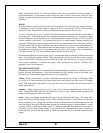
PROBLEM CAUSE SOLUTION
Lack of Heat (continued) Severely cold weather
Naturally you will require more fuel in the
middle of winter than in the fall.
Overdraft
Turn the rotary damper toward the closed
setting until the draft is reduced.
Draft controls not
adjusted
Combustion is restricted when the air is
restricted. Be certain that the air intake is
properly adjusted and open enough.
Bad wood
Hard wood gives more heat than soft wood.
Rotten wood of any type gives very poor heat,
burns quickly and produces excessive ash.
Blower Inoperative Controls
Check Circuit Breaker. Ensure the thermostat
is properly set and fire has warmed the firebox
and air discharge snap disc. The fan speed
should be set to the appropriate speed not to
the “off” position.
Sensor switch
Only comes on when the discharged air
reaches 110 degrees or higher. Test the air
discharge snap disc with a hair dryer. Fans
should begin to operate if both the wall
thermostat and air discharge snap disc
completes the blowers’ electrical circuit.
Excessive creosote Poor quality wood
Unseasoned wood will produce more creosote
than dry, seasoned wood. Buying your wood
early will avoid these problems.
Heater Controls shut
down too tight
Closing the draft controls too tight prevents
the entry of air necessary for complete
combustion. Open your draft controls for up
to 20 minutes once a day to burn off
accumulations of creosote. Proper use of
commercial preparations will also give
satisfactory results.
Humidifier
Adding moisture to the air, as when a
humidifier is used, will increase the creosote
formation. Be sure to clean your flue more
often and burn your fires hotter.
Brass tarnishes Normal
Flitz and other commercial preparations work
very well for a bright, clear shine. Avoid
placing fingers on brass to preserve the
appearance.
Version 7.1
32


















